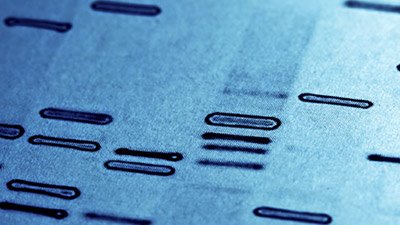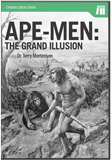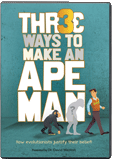
South Carolina Man’s DNA Tells Ancient Story
When a relative of Albert Perry, an African-American man in South Carolina (now recently deceased), decided to send his DNA sample to the National Geographic Genographic Project, she created quite a stir in the world’s genomic databases.
News Source
- ScienceDaily: “Human Y Chromosome Much Older Than Previously Thought”
Mr. Perry’s Y-chromosome didn’t match any of the data on file. Family Tree DNA took up the search for Mr. Perry’s ancestral roots, and their surprising discoveries and conclusions have just been published in the American Journal of Human Genetics.
Michael Hammer, whose laboratory sorted through the mystery, says, “The most striking feature of this research is that a consumer genetic testing company identified a lineage that didn't fit anywhere on the existing Y chromosome tree, even though the tree had been constructed based on perhaps a half-million individuals or more. Nobody expected to find anything like this.”

The normal male human chromosomes include one X (left) and one Y chromosome, which is much smaller. Only males have the Y chromosome. Because it is only inherited from the father, it is useful for tracking ancestral relationships. A 240,000 base portion of Mr. Perry’s Y-chromosome was compared to the database that has been accumulating in recent years and found to reflect a rare lineage. Image courtesy of University of Arizona through www.sciencedaily.com

This family tree illustrates the reason mitochondrial DNA and Y chromosomes are useful for tracing ancestry. Only males have Y chromosomes, and being unmixed with DNA from the mother, the mutation pattern on the Y chromosome can be matched with similar patterns in other people whose DNA happens to be in the database. In this way, people can be grouped according to their shared common ancestors. Similarly, even though everyone has mitochondrial DNA, it is passed on through the mother, so its mutation patterns can also be traced. But the effort to determine how long ago people in a particular group (like Mr. Perry and the Mbo men from Cameroon) shared a common ancestor is fraught with many unverifiable assumptions and therefore flawed. Image credit: saypeople.com
The Y-chromosome is the easiest-to-track portion of men’s genomes since it is only passed on through males without any mixing of parental genes. (Mitochondrial DNA, similarly, is the easiest to track in women, as it is passed on through daughters.) Over time, chromosomes mutate quite a bit, and most of those mutations don’t hurt anything. But those point mutations do produce unique combinations that can be used to trace ancestral relationships and sometimes even geographical origins.
Further research eventually tracked Mr. Perry’s unusual combination of genetic variants to the Mbo people of western Cameroon in sub-Saharan Africa. “The sample matched the Y chromosome DNA of 11 men, who all came from a very small region of western Cameroon,” explains Hammer. “And the sequences of those individuals are variable, so it's not like they all descended from the same grandfather.”
Having discovered that Mr. Perry’s roots stretched back to a place not widely represented in genetic databases, the next question was to ask what sort of people were they? Why are they so minimally represented in the modern gene pool? Can we know how far back we would have to go to find the common ancestor of Mr. Perry and these Mbo men? And from the evolutionary point of view, of course, what are the implications for humanity’s origins?
First of all, it is important to note that all of the DNA in question is ordinary human DNA, not some sort of sub-human hybrid or transition—which of course never existed, we creationists argue. But researchers believe, on the basis of their molecular clock calculations, that the lineage of Mr. Perry and these eleven Mbo men reaches back too far to be from the anatomically modern humans in the fossil record. They therefore propose that some sort of genetic contribution from archaic humans is present in the DNA.
Evolutionists currently estimate that Neanderthals diverged from ancestral humans about 300,000 years ago and that anatomically modern humans then evolved about 195,000 years ago. This belief is based on radiometric dating of the rock layers near to sites where anatomically modern human fossils are found. But calculations based on Mr. Perry’s Y-chromosome suggest his ancestors were much older. Hammer says, “Our analysis indicates this lineage diverged from previously known Y chromosomes about 338,000 ago, a time when anatomically modern humans had not yet evolved. This pushes back the time the last common Y chromosome ancestor lived by almost 70 percent.”
Since mutations accumulate over time, the more time elapsed since people groups shared a common ancestor should generally be reflected in greater genetic diversity. Previously, data on DNA diversity has suggested that people containing the most diverse genetic material hail from other regions in Africa.
Finding the unusual Y-chromosome represented among the Mbo, Hammer says, “was surprising because previously the most diverged branches of the Y chromosome were found in traditional hunter-gatherer populations such as Pygmies and the click-speaking KhoeSan, who are considered to be the most diverged human populations living today. (See Presence of Ancient Anatomically Modern Humans in Africa and Another Variety of Archaic Humans for more about them.)
Despite the common designation of the oldest last common ancestor of various groups as “mitochondrial Eve” or “Y chromosome Adam,” Hammer points out that the data suggests neither anything biblical nor any single ancestral human. “There has been too much emphasis on this in the past,” he says. “It is a misconception that the genealogy of a single genetic region reflects population divergence [from a single pair of people]. Instead, our results suggest that there are pockets of genetically isolated communities that together preserve a great deal of human diversity.”
Instead, the molecular clock conclusions imply that Perry’s ancestors may have included archaic humans who are now extinct. And in 2011, human fossils combining modern and “unexpectedly archaic features”1 were found in the Nigerian village of Iwo Eleru. Hammer says, “The Cameroon village with an unusual genetic signature is right on the border with Nigeria, and Iwo Eleru is not too far away.”2 He adds, “It is likely that other divergent lineages will be found, whether in Africa or among African-Americans in the U.S. and that some of these may further increase the age of the Y chromosome tree.”
Molecular clock calculations appear authoritative and factual, but they are only as good as the standard by which they are calibrated.
So is this proof that humans evolved earlier than thought, or even that they evolved at all? No. Molecular clock calculations appear authoritative and factual, but they are only as good as the standard by which they are calibrated. And they are calibrated using unverifiable assumptions about the unobservable untestable past.
Mutation rates, for instance, must be constant for clock conclusions to be valid. Even in the present, that assumption has already been disproven in humans (as discussed in Scientists Admit Genetic Data Timing Uncertain and Molecular Clock Off-Line), and there is no way to observe past mutation rates.
Furthermore, molecular clock predictions are built upon a statistical house of cards, attempting to predict how long evolution would take if it could happen and if mutation rates were known to be stable. And human molecular clocks, in particular, rely heavily on the assumption that chimps and humans share an ape-like ancestor. The expected time for differences to diverge from this hypothetical ape-like ancestor to produce modern human and chimp DNA is often used to calibrate the data.
As to the statistical methods at the heart of molecular clock dating, evolutionary authors summed up the problems well in a 2004 article in Trends in Genetics. They wrote, “In this article, we document the manner in which a calibration point that is both inaccurate and inexact—and in many instances inapplicable and irrelevant—has been used to produce an exhaustive evolutionary timeline that is enticing but totally imaginary.” Therefore, they write, “Despite their allure, we must sadly conclude that all divergence estimates discussed here are without merit. Our advice to the reader is: whenever you see a time estimate in the evolutionary literature, demand uncertainty.”3
The assumptions on which the molecular clock dating of human origins is based are as unverifiable and flawed as those of radiometric dating. Therefore, while Mr. Perry clearly has a unique heritage, we reject the vast age estimates for his lineage.
“Creationists and most evolutionists believe that at some point people migrated out from some central location,” explains Dr. Georgia Purdom, molecular geneticist with Answers in Genesis. “When that occurred is the issue. The evolutionists’ time frame is wrong, and that’s because their assumptions are wrong.”
But this information is actually quite exciting in another way. Mr. Perry’s ancestral roots, now known to reach back to the same place as those of a few men in Cameroon, are evidence of the diversity we see as a result of the dispersion from the Tower of Babel. The rare DNA markers in this lineage are a record of some of the people who migrated out from there, human beings whose individual life stories are lost in roughly 4,000 years of history but who were just as human as we are. Mr. Perry’s DNA is therefore a link to the human diversity we all share, having all descended from Noah’s family.
Further Reading
- Presence of Ancient Anatomically Modern Humans in Africa (African melting pot)
- Trace Your Family History through DNA Testing
- Another Variety of Archaic Humans (genetic evidence found)
- Researchers Devise Alternate Theory For Cambrian Explosion (circular clock)
- Molecular Clock Off-Line (slow mutation rates)
- Scientists Admit Genetic Data Timing Uncertain (gorilla genome’s surprises)
- Mitochondrial Eve (Eve’s getting older)
- “The Search for the Historical Adam” and Population Genomics
- Was the Tower of Babel Dispersion a Real Event?
- Neanderthals vs. Humans: Are They Different?
- When Did Cavemen Live?
- Were Cavemen Real?
- Four Women, a Boat, and Lots of Kids
- Radiometric Dating
- Radiometric Dating: Problems with the Assumptions
- Radiometric Dating: Making Sense of the Patterns
For More Information: Get Answers
Remember, if you see a news story that might merit some attention, let us know about it! (Note: if the story originates from the Associated Press, FOX News, MSNBC, the New York Times, or another major national media outlet, we will most likely have already heard about it.) And thanks to all of our readers who have submitted great news tips to us. If you didn’t catch all the latest News to Know, why not take a look to see what you’ve missed?
(Please note that links will take you directly to the source. Answers in Genesis is not responsible for content on the websites to which we refer. For more information, please see our Privacy Policy.)
Footnotes
- www.newscientist.com/article/dn23240-the-father-of-all-men-is-340000-years-old.html
- Ibid.
- Dan Graur and William Martin, “Reading the Entrails of Chickens: Molecular Timescales of Evolution and the Illusion of Precision,” Trends in Genetics 20 (2004): 80–86, www.molevol.de/publications/117.pdf
Recommended Resources

Answers in Genesis is an apologetics ministry, dedicated to helping Christians defend their faith and proclaim the good news of Jesus Christ.
- Customer Service 800.778.3390
- © 2024 Answers in Genesis






